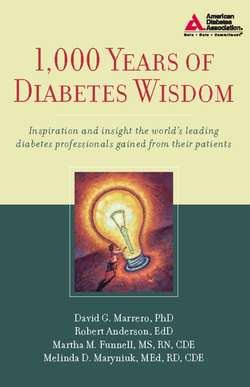Читать книгу 1,000 Years of Diabetes Wisdom - David G. Marrero - Страница 14
Walking in the Patient’s Shoes
Оглавлениеby Seyda Ozcan, nurse, Istanbul, Turkey
I have been working with people with diabetes for almost 15 years. In the beginning, I was both enthusiastic and inexperienced, I felt that any goal could be achieved if you were willing to work hard enough. I believed that anyone’s diabetes could be managed successfully if the patient really wanted to succeed. Unfortunately, with this naive optimisim, I sometimes made light of the difficulties reported by my patients. I had no real appreciation of the challanges they faced on a daily basis until one morning nearly five years ago.
I finished my morning appointments with the patients in the dibetes clinic. After lunch, I left from the clinic to attend to a diabetes postgraduate course. I met my friends in the lobby next to the pharmaceutical company’s exhibition area. While we were chatting, a man from one of the companies asked if he could check my blood glucose to demonstrate their new meter. He did the check and told me the result.
After a few seconds, the expression on his face and what he said sunk in. My blood glucose was 196 mg/dl. All of us thought the meter was out of order or the strips had expired. He opened a new bottle of strips and measured again with another meter. It was the same. my friends, who were physicians, dietitians, and nurses, were shocked by this result.
The representitive gave me a meter and some strips so I could check my blood glucose levels later. I figured that I would recheck later and see that the earlier result was incorrect. We went to the meeting room but I couldn’t concentrate on the presentation. I left early to go home.
I began examining my lifestyle, especially my unhealthy habits. I was eating too much junk food, too many desserts, and too much chocalate. I decided that the first thing I had to do was to eat healthy. But how? I love chocolate and the idea of giving it up made me miserable. I knew that recently I had gained weight and that I needed to start exercising. I thought to myself, “I can do this. I like exercise.” But mostly I thought, “I can’t possibily have diabetes, maybe I have impaired glucose tolerance (IGT).” At my age and weight I knew this must be type 1, which meant there was only one choice. I was going to have to take insulin. There was no getting around it.
I thought about all of this on the drive home. As soon as I arrived, I washed my hands and measured my blood glucose again, it was 172 mg/dl. I prepared a very healthy dinner with modest portions. I rechecked my blood glucose after one hour and once again after two. Although I ate a very small meal, it was still high. Part of my mind was saying, “Why is this such a big problem? You are a diabetes specialist. You explain to your patients how they can live well with diabetes, offer support, and encourage them by giving examples of how other patients manage. So why are you so upset?” Then I realized that it is one thing to know about diabetes, but knowing is utterly different from having diabetes. I felt overwhelmed as I lay in bed crying. I finally fell asleep after making some important decisions about changing my life.
Although the next day was Saturday, I woke up early and walked for two hours. Then I ate a very healthy breakfast. I checked my blood sugar before and after breakfast, and at last I saw normal numbers. I checked my sugar seven times that Saturday, and then again on Sunday. My blood sugar remained normal. All of my test results to diagnose diabetes were normal. No one could offer an explanation consistent with current scientific knowledge about the cause of this one-day episode of diabetes.
I am now acutely aware that what we know about diabetes through study is very different from the reality of experiencing it directly. Now I feel closer to my patients and appreciate the importance of listening attentively to each of them. Each patient’s experience is unique and I do my utmost to understand and acknowledge their uniqeness.
